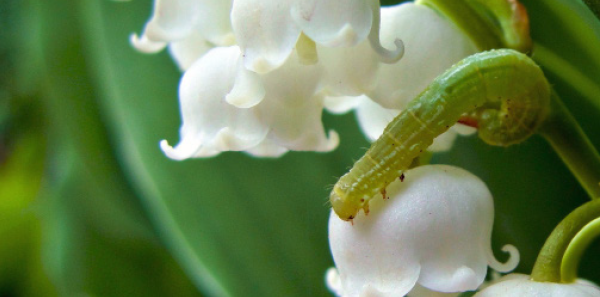
Answer: Lily of the valley
Explore This Issue
ACEP Now: Vol 41 – No 03 – March 2022Description
Although part of the asparagus family and potentially deadly, the flower has a scent that makes it one of the most beloved plants in the world. The flowers grow from underground rhizomes, so they will spread and take over an area of the garden if not planted with boundaries.
In the spring, each stem produces two long pointed leaves and a central raceme (a flower cluster with individual blossoms along a central stem) with five to 15 bonnet-shaped white flowers. Later in the growing season, the flowers are replaced by berries that range in color from red to orange.
Toxin and Dose
The plant contains a long list of toxins, mainly cardiac glycosides (some authors report 20–40)—primarily convallarin and convallamarin—that affect the heart and saponins that affect the gastrointestinal (GI) tract. The entire plant contains toxins; its leaves, berries, stems and roots are all poisonous.
It is reported that severe poisoning might occur after ingestion of a seemingly small amount or “two stems with leaves.” The water that cut stems are placed in may also contain enough toxins to poison someone trying to “taste the perfume.”
Symptoms of toxicity include nausea, vomiting, general malaise, chest pain, weakness, altered mental status, very slow heart rate, irregular heartbeat, ectopy and cardiac arrest.
Treatment is primarily supportive. GI decontamination with activated charcoal can be considered. Although there is no clear antidotal therapy, the use of digoxin-specific Fab fragments has been suggested.
Similar Poisons
Other naturally occurring compounds with structures similar to these cardioactive steroids include bufadienolides (Bufo spp of toads), fireflies (Photinus spp), oleandrin (Nerium spp), cerebins (from Cerbera odollam, pong-pong or “suicide” tree) and ouabain (Acokanthera schimperi tree). This last one deserves some attention as it is where the African crested rat sources the poison it wicks into its fur—it’s the only known mammal that intentionally coats itself in poison! It’s totally worth a look if you are unfamiliar with this awesome animal.*
Cultural Background
Did you know the lily of the valley is the national flower of Finland?
It is often used in bouquets, in tabletop floral arrangements and as scent in soaps and perfumes. Bridal bouquets, including those of royal families, use it for its sweet perfume, and it was in the bouquets of Catherine, Duchess of Cambridge, and Princess Grace Kelly of Monaco. Plus, it is said to be Queen Elizabeth II’s favorite flower. In the language of flowers, lily of the valley symbolizes purity, humility and a return to happiness.
The flower is traditionally associated with May Day, especially in France where the muguet is handed out at special events. The lily of the valley image is a frequently used motif in artwork, including those by Marc Chagall, Marx Reichlich, Carl Fabergé and others.
*Listen to this three-minute NPR podcast on the African crested rat.
Pages: 1 2 | Single Page






No Responses to “Toxicology Answer: the Lovely Lily of the Valley”